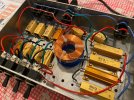Finally got round to building this. Thanks John H for your generosity in sharing the design. My previous experience with attenuators was with a Weber Mass and this easily surpasses it. I also have a Two Note Captor X. I find the Two Note to be a tad more transparent and has more presence but the fixed attenuation levels is inconvenient as I am using it with a non-master volume amp.
This thread is a great resource for anyone looking at an affordable solution. Hats off to you mate!
This thread is a great resource for anyone looking at an affordable solution. Hats off to you mate!









 )
)